1995 OLDSMOBILE SILHOUETTE brake light
[x] Cancel search: brake lightPage 9 of 390
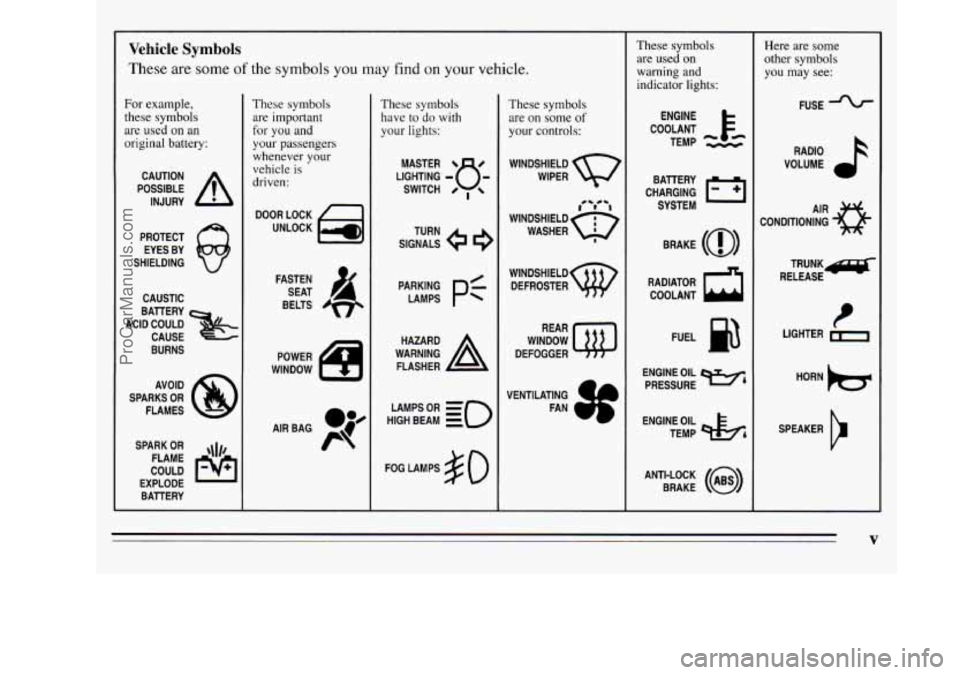
L
Vehicle Symbols
These are some of the symbols you may find on your vehicle.
For example,
these symbols are used on an
original battery:
POSSIBLE A
CAUTION
INJURY
PROTECT EYES BY
SHIELDING
CAUSTIC
ACID COULD BAlTERY
CAUSE
BURNS
AVOID
SPARKS
OR
FLAMES
SPARK
OR ,111,
COULD FLAME
EXPLODE BAllERY
These symbols are important
for you and
your passengers whenever your
vehicle is
driven:
DOOR LOCK
UNLOCK
FASTEN SEAT
BELTS
POWER
WINDOW
These symbols have to do with
your lights:
SIGNALS e e3
TURN
WARNING
A
HAZARD
FLASHER
HIGH
LAMPSoR BEAM = zo
FOG LAMPS $0
These symbols
are on some
of
your controls:
WINDSHIELD
WIPER
WINDSHIELD DEFROSTER
WINDOW
DEFOGGER
VENTILATING FAN
These symbols are used on
warning and
indicator lights:
COOLANT F-
TEMP --
ENGINE
CHARGING BAllERY
SYSTEM
BRAKE
(a)
RADIATOR COOLANT
a
FUEL
ENGINE OIL
PRESSURE
w4
TEMP OIL pk;
ANTI-LOCK (a)
BRAKE
Here are some
other symbols
you may see:
FUSE
RADIO
VOLUME
CONDITIONING
43
TRUNX~
RELEASE
HORN
)tr
SPEAKER
b
V
ProCarManuals.com
Page 92 of 390
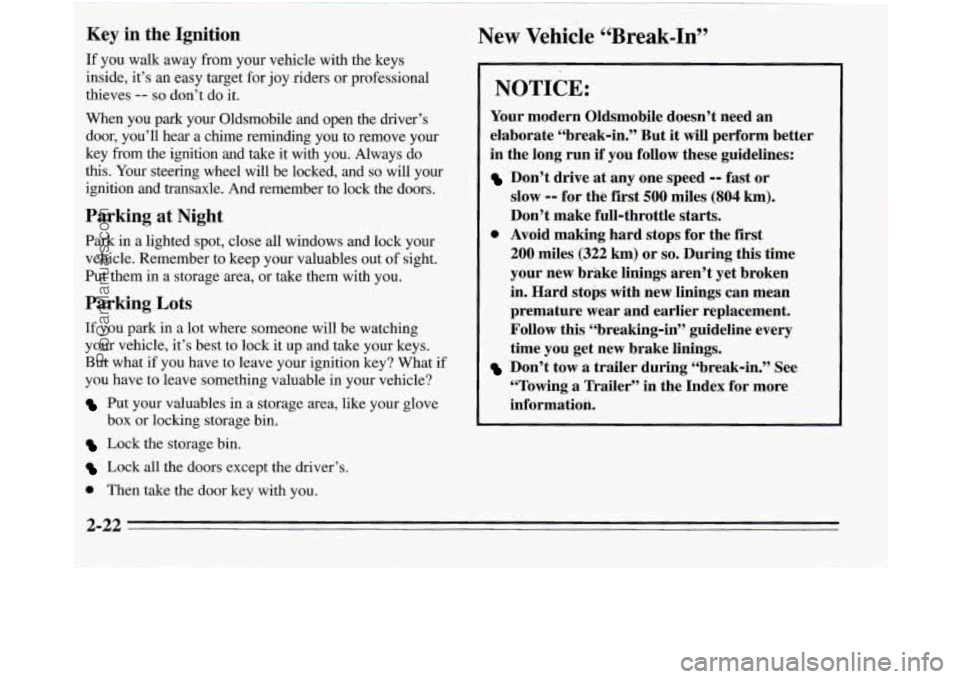
Key in the Ignition
If you walk away from your vehicle with the keys
inside, it’s an easy target for joy riders or professional
thieves
-- so don’t do it.
New Vehicle ''Break-in"
When you park your Oldsmobile and open the driver’s
door’ you’ll hear a chime reminding you to remove your
key from the ignition and take it with you. Always
do
this. Your steering wheel will be locked, and so will your
ignition and transaxle. And remember to lock the doors.
Parking at Night
Park in a lighted spot, close all windows and lock your
vehicle. Remember to keep your valuables out
of sight.
Put them in a storage area, or take them with you.
Parking Lots
If you park in a lot where someone will be watching
your vehicle, it’s best to lock it up and take your keys.
But what if you have to leave your ignition key? What if
you have
to leave something valuable in your vehicle?
Put your valuables in a storage area, like your glove
box or locking storage bin.
Lock the storage bin.
Lock all the doors except the driver’s.
0 Then take the door key with you.
NOTICE:
Your modern Oldsmobile doesn’t need an
elaborate “break-in.” But it
will perform better
in the long run if you follow these guidelines:
Don’t drive at any one speed -- fast or
slow
-- for the first 500 miles (804 km).
Don’t make full-throttle starts.
200 miles (322 km) or so. During this time
your new brake linings aren’t yet broken
in. Hard stops with new linings can mean
premature wear and earlier replacement.
Follow this “breaking-in” guideline every
time you get new brake linings.
Don’t tow a trailer during “break-in.” See
“Towing
a Trailer” in the Index for more
information.
0 Avoid making hard stops for the first
2-22
ProCarManuals.com
Page 102 of 390
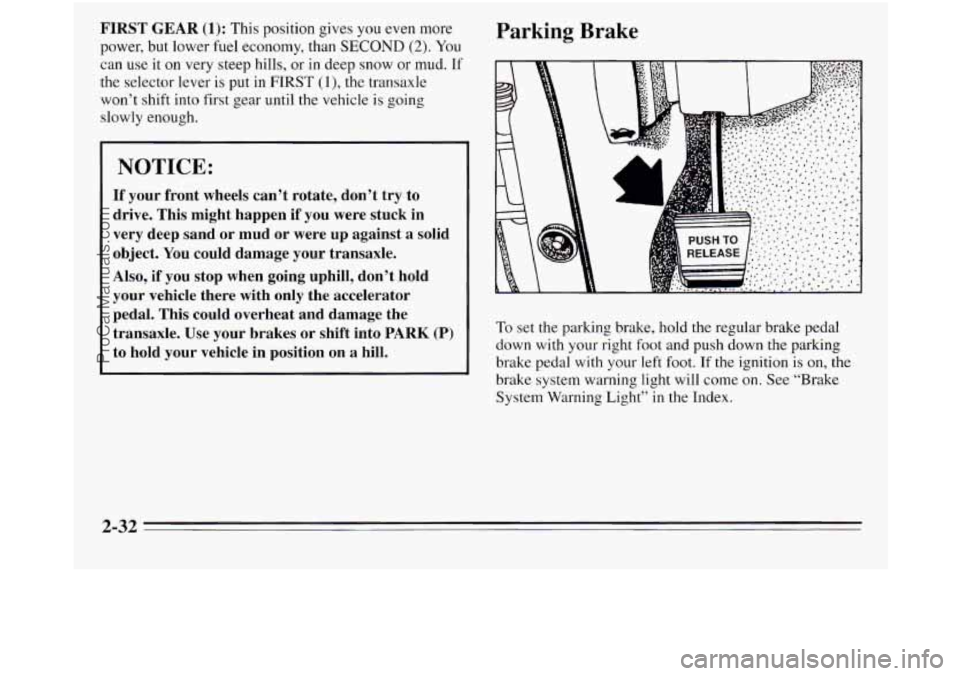
FIRST GEAR (1): This position gives you even more
power,
but lower fuel economy, than SECOND (2). You
can
use it on very steep hills, or in deep snow or mud. If
the selector lever is put in FIRST
(1), the transaxle
won’t shift into first gear until the vehicle is going
slowly enough.
_-
NOTICE:
If your front wheels can’t rotate, don’t try to
drive. This might happen if you were stuck in
very deep sand or mud
or were up against a solid
object. You could damage your transaxle.
Also, if you stop when going uphill, don’t hold
your vehicle there with only the accelerator
pedal. This could overheat and damage the
transaxle.
Use your brakes or shift into PARK (P)
to hold your vehicle in position on a hill.
Parking Brake
To set the parking brake, hold the regular brake pedal
down with your right foot and push down the parking
brake pedal with your left foot. If the ignition is on, the
brake system warning light will come on. See “Brake
System Warning Light” in the Index.
ProCarManuals.com
Page 118 of 390
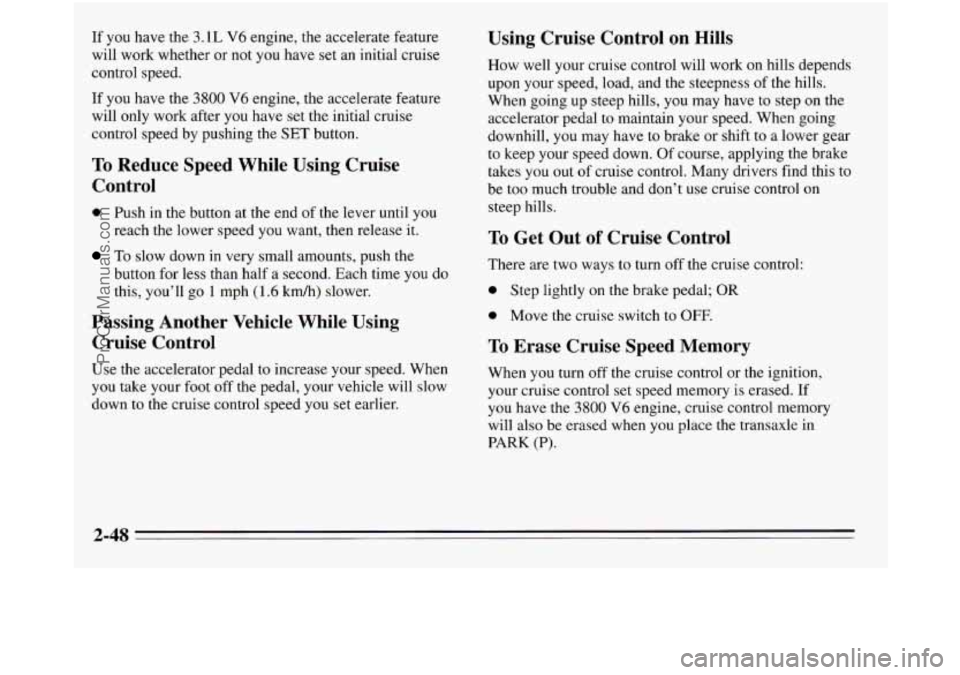
If you have the 3.1L V6 engine, the accelerate feature
will work whether or not you have set an initial cruise
control speed.
If you have the
3800 V6 engine, the accelerate feature
will only work after you have set the initial cruise
control speed by pushing the
SET button.
To Reduce Speed While Using Cruise
Control
0 Push in the button at the end of the lever until you
reach the lower speed you want, then release
it.
To slow down in very small amounts, push the
button for less than half a second. Each time you do
this, you’ll
go 1 mph (1.6 km/h) slower.
Passing Another Vehicle While Using
Cruise Control
Use the accelerator pedal to increase your speed. When
you take your foot
off the pedal, your vehicle will slow
down
to the cruise control speed you set earlier.
Using Cruise Control on Hills
How well your cruise control will work on hills depends
upon your speed, load, and the steepness of the hills.
When going up steep hills, you may have to step on the
accelerator pedal to maintain your speed. When going
downhill, you may have to brake or shift to a lower gear
to keep your speed down.
Of course, applying the brake
takes you out
of cruise control. Many drivers find this to
be too much trouble and don’t use cruise control on
steep hills.
To Get Out of Cruise Control
There are two ways to turn off the cruise control:
0 Step lightly on the brake pedal; OR
0 Move the cruise switch to OFF.
To Erase Cruise Speed Memory
When you turn off the cruise control or the ignition,
your cruise control set speed memory is erased. If
you have the
3800 V6 engine, cruise control memory
will also be erased when you place the transaxle
in
PARK (P).
2-48
ProCarManuals.com
Page 143 of 390
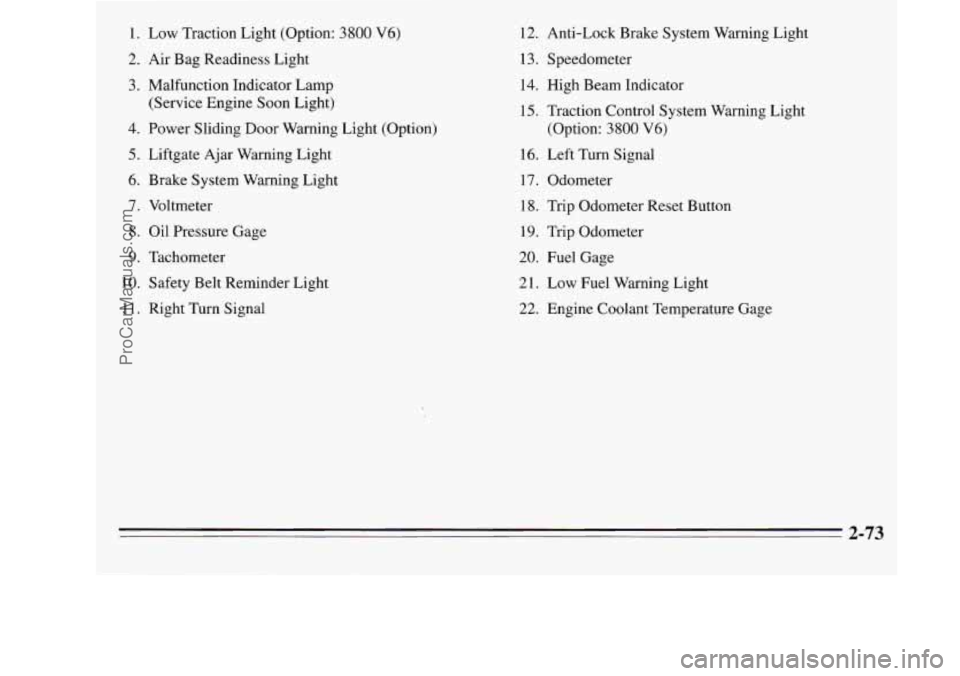
1. Low Traction Light (Option: 3800 V6)
2. Air Bag Readiness Light
3. Malfunction Indicator Lamp
(Service Engine Soon Light)
4. Power Sliding Door Warning Light (Option)
5. Liftgate Ajar Warning Light
6. Brake System Warning Light
7. Voltmeter
8. Oil Pressure Gage
9. Tachometer
10. Safety Belt Reminder Light
11. Right Turn Signal 12.
Anti-Lock Brake System Warning Light
1 3. Speedometer 14. High Beam Indicator
15. Traction Control System Warning Light
(Option: 3800
V6)
16. Left Turn Signal
17. Odometer
18. Trip Odometer Reset Button
19. Trip Odometer
20. Fuel Gage
21. Low Fuel Warning Light
22. Engine Coolant Temperature Gage
2-73
ProCarManuals.com
Page 147 of 390
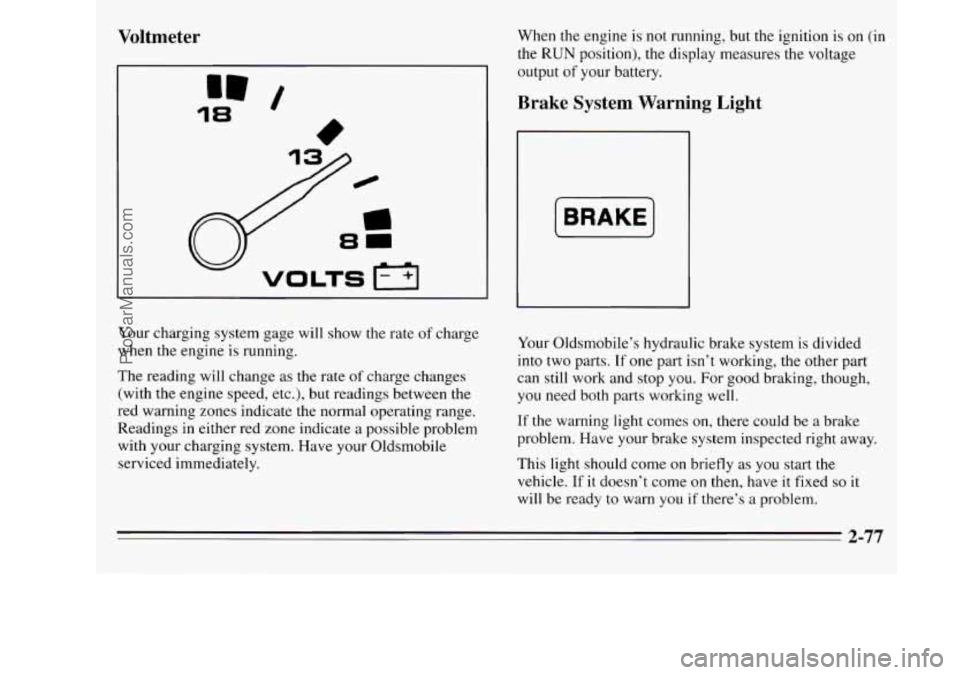
Voltmeter
18
” /
When the engine is not running, but the ignition is on (in
the RUN position), the display measures the voltage
output
of your battery.
Brake System Warning Light
[BRAKE]
Your charging system gage will show the rate of charge
when the engine is running.
The reading will change as the rate
of charge changes
(with the engine speed, etc.), but readings between the
red warning zones indicate the normal operating range.
Readings in either red zone indicate
a possible problem
with your charging system. Have your Oldsmobile
serviced immediately. Your
Oldsmobile’s hydraulic brake system is divided
into two parts.
If one part isn’t working, the other part
can still work and stop
you. For good braking, though,
you need both parts working well.
If the warning light comes on, there could be a brake
problem. Have your brake system inspected right away.
This light should come on briefly as you start the
vehicle.
If it doesn’t come on then, have it fixed so it
will be ready to warn
you if there’s a problem,
2-77
ProCarManuals.com
Page 148 of 390
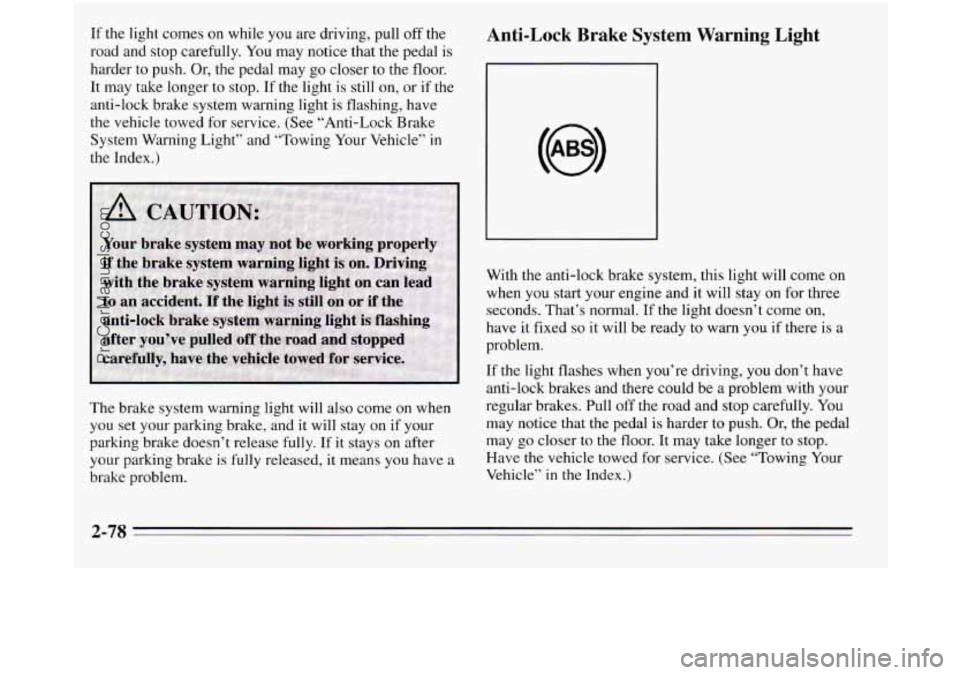
If the light comes on while you are driving, pull off the
road and stop carefully. You may notice that the pedal is
harder to push. Or, the pedal may go closer to the floor.
It may take longer
to stop. If the light is still on, or if the
anti-lock brake system warning light is flashing, have
the vehicle towed for service. (See “Anti-Lock Brake
System Warning Light” and “Towing Your Vehicle”
in
the Index.)
The brake system warning light will also come
on when
you set your parking brake, and it will stay on if your
parking brake doesn’t release fully. If it stays on after
your parking brake is fully released, it means you have a
brake problem.
Anti-Lock Brake System Warning Light
With the anti-lock brake system, this light will come on
when you start your engine and it will
stay on for three
seconds. That’s normal. If the light doesn’t come on,
have it fixed
so it will be ready to warn you if there is a
problem.
If the light flashes when you’re driving, you don’t have
anti-lock brakes and there could be
a problem with your
regular brakes. Pull
off the road and stop carefully. You
may notice that the pedal is harder to push. Or, the pedal
may go closer to the floor. It may take longer
to stop.
Have the vehicle towed for service. (See “Towing Your
Vehicle” in
the Index.)
2-78
ProCarManuals.com
Page 149 of 390
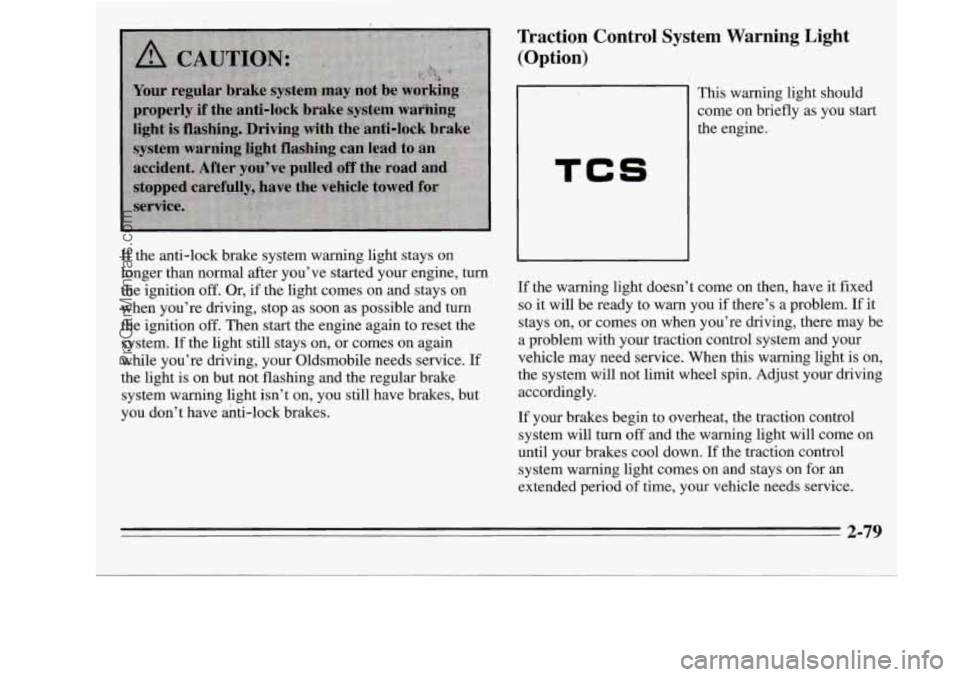
If the anti-lock brake system warning light stays on
longer than normal after you’ve started your engine,
turn
the ignition off. Or, if the light comes on and stays on
when you’re driving, stop as soon as possible and turn
the ignition
off. Then start the engine again to reset the
system. If the light still stays on, or comes on again
while you’re driving, your Oldsmobile needs service.
If
the light is on but not flashing and the regular brake
system warning light isn’t on, you still have brakes, but
you don’t have ahti-lock brakes.
Traction Control System Warning Light
(Option)
TCS
This warning light should
come on briefly as you start
the engine.
If the warning light doesn’t come on then, have it fixed
so it will be ready to warn you if there’s a problem. If it
stays on, or comes on when you’re driving, there may be
a problem with your traction control system and your
vehicle may need service. When this warning light
is on,
the system will not limit wheel spin. Adjust your driving
accordingly.
If your brakes begin to overheat, the traction control
system will
turn off and the warning light will come on
until your brakes cool down. If the traction control
system warning light comes on and stays on for an
extended period
of time, your vehicle needs service.
2-79
ProCarManuals.com